
Introduction
The focus of next few chapters is to introduce base metals and talk about the key factors that impact them. Base metals are also referred to as industrial metals due to their widespread usage in industrial and construction activities, or as nonferrous metals as they do not contain iron. Unlike precious metals, base metals are found in abundance in the earth’s crust and are relatively easy to extract. Because of this, they are much more affordable than precious metals. The most widely traded base metals are:
- Copper
- Aluminium
- Zinc
- Lead
- Nickel
Because of their affordability and characteristics, base metals are extensively used in various activities such as construction, infrastructure, manufacturing etc. In fact, base metals are a part of our day to day lives as they are used in almost all our home equipments, devices, and across a range of products that we use every day. Because of their widespread usage, it is therefore not surprising that base metals are considered a leading indicator of global economic health. This is because a strengthening economy coincides with an increase in infrastructural, manufacturing, and construction activities. And if there is an increase in such activities, it should naturally mean more demand for base metals.
Base metals are traded in almost all derivative exchanges around the world. The three most important exchanges for base metals trading are LME (London Metal Exchange, UK), COMEX (Commodity Exchange Inc., US), and SHFE (Shanghai Futures Exchange, China). Of these, LME is arguably the most important exchange as it rightly called the global hub of base metals trading. In India, most of the base metals volume occurs on the MCX, where each of the five metals mentioned above are heavily traded. We shall now talk about each of the metal in more detail.
Copper
Copper is arguably the most important, the most eyed, and one of the most widely used nonferrous metal in the world. It is a reddish metal that has been used since ages for a wide range of purposes. In fact, it is believed that copper is the oldest metal man has known. Since its discovery, the usage of copper has only increased, and this trend is expected to continue into the foreseeable future too.
Copper is an exceptional conductor of heat & electricity and is also is also corrosion resistant. Because of these features, copper is heavily used across a range of activities such as manufacturing, construction, and infrastructure. Other than these traditional uses, copper has other uses too. For instance, copper has medical uses, copper helps in the purification of drinking water, copper is present in some of the foods that humans & animals consume and is vital in maintaining good health, copper alloys are used to make other industrial metals etc. It is hard to imagine how this world would have evolved without the availability of copper.
Copper usage
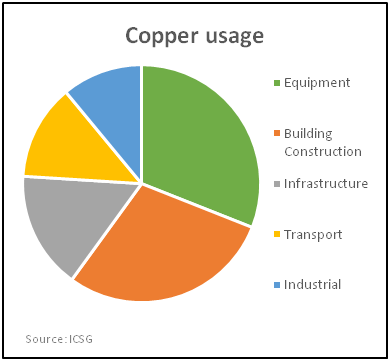 Copper is an exceptional conductor of heat and electricity, is corrosion resistant, is highly durable, ductile, malleable, can be cast with high precision, and has low toxicity to humans. Adding to all this, copper is also relatively inexpensive. Because of all these factors, copper is one of the most widely used base metal in the world. It’s no wonder why copper is commonly referred to as ‘Dr Copper’. The red metal is considered as a leading indicator of economic health. This is because when economies expand, so do their infrastructure such as roads, bridges, railways, dams, buildings, etc. Also, economic expansion leads to improving standard of living of people and an increase in demand for consumer products, such as vehicles, electronics etc. This in turn increases manufacturing and other industrial activities. All these increase demand for copper, which forms the base of any economic progress. Hence, copper’s role in global economic development is invaluable.
Copper is an exceptional conductor of heat and electricity, is corrosion resistant, is highly durable, ductile, malleable, can be cast with high precision, and has low toxicity to humans. Adding to all this, copper is also relatively inexpensive. Because of all these factors, copper is one of the most widely used base metal in the world. It’s no wonder why copper is commonly referred to as ‘Dr Copper’. The red metal is considered as a leading indicator of economic health. This is because when economies expand, so do their infrastructure such as roads, bridges, railways, dams, buildings, etc. Also, economic expansion leads to improving standard of living of people and an increase in demand for consumer products, such as vehicles, electronics etc. This in turn increases manufacturing and other industrial activities. All these increase demand for copper, which forms the base of any economic progress. Hence, copper’s role in global economic development is invaluable.
Nearly a third of the demand for copper comes from electrical and electronic equipments. The metal is extensively used in most of the electrical wirings around the world. Copper is an important component of renewable sources of energy, wherein it is used in photovoltaic cells and wind turbines. Moreover, copper is widely used in a range of electronic appliances such as televisions, mobile phones, computers, refrigerators, air-conditionersetc. Within these equipments, copper is used in electronic connectors, circuit wiring andboard, semi-conductors, micro-chips, wirings, plates etc. Copper also plays a key role in the telecommunication sector, wherein it is used in telephone wiring and to enable the transmission of high-speed internet.
The second largest source of copper demand is construction, again accounting for nearly a third of global copper demand.Because of copper’s antimicrobial properties, it is a preferred choice of metal for heating and water equipments that are used in bathrooms and in kitchens. Given that copper is ductile and malleable, it is used extensively in plumbing, house fittings, roofing, and a range of other building interiors such as locks, lightings, handles etc. Copper’s pleasing, reddish colour, also makes it a preferred choice of metal for the construction of important architectures such as government buildings, cathedrals etc.
The third major source of copper demand is infrastructure, occupying a sixth of total demand. Copper is heavily used for developing a nation’s infrastructural facilities. This is especially the case for emerging market or developing nations such as China and India, which see higher growth and economic expansion due to the rapid pace of urbanization. As infrastructural facilities increase in the form of roads, bridges, dams, airports, highways etc., so does the demand for copper.
Copper is also extensively used in transportation. The metal plays a vital role in the proper functioning and safety of a vehicle. Today, depending on the size, cars contain anywhere between 20 to 45 kilograms of copper in wiring, motors, brakes, connectors, and bearings. Today, an area where copper is gaining significant prominence is in Electric Vehicles (EVs) segment. Because of the EV boom that is expected to take place over the next several years, the share of copper demand from this sector is expected to increase significantly in the years ahead. On average, an EV consumes 4 times more copper than a conventional Internal Combustion Engine (ICE) vehicle. EVs, which currently have a share of less than 2% in total sales, is expected to account for more than half of all vehicles by 2040.(Legend: BEV = Battery Electric Vehicle, HEV = Hybrid Electric Vehicle, PHEV = Plug-in Hybrid Electric Vehicle, ICEV = Internal Combustion Engine Vehicle)
Factors that impact the price of copper
As already stated, copper is considered a leading indicator of global economic health. The price of copper is closely impacted by the health of the global economy as this shapes up the demand trajectory for the metal. Unlike gold and silver, which are more impacted by demand-side factors than supply-side factors, copper prices are heavily impacted by supply-side factors also. The major factors that drive the movement of copper prices are as stated below:
Economic health of China
This is one of the most important factors that influence the price of copper. The reason why this is so is because China is the world’s largest copper consumer, accounting for half of the global demand each year. Given the mammoth size of its economy, China has a significant impact on the health of the world economy too. As per the World Economic Forum, China contributes to over a third of world GDP each year. As such, copper movement in heavily impacted by the health of China. Any weakness in Chinese economy puts a considerable drag on copper prices, and vice versa. There is a common adage, which says ‘When China sneezes, the rest of the world catches a cold’. This cannot be truer, especially over the last few years, as Chinese economic slowdown has been impacting the health of the world economy and copper prices too. Notice in the chart how deceleration in the pace of Chinese GDP has been dragging copper prices lower since 2010. Hence, it becomes extremely important to keep a track of Chinese health. One must closely monitor key economic statistics from China such as GDP, housing and construction, inflation, manufacturing, infrastructure spending, money supply, retail sales, central bank and government policy actions etc., in order to analyse its impact on Chinese copper demand and subsequently on copper prices too.
Economic health of other nations
While economic health of China has arguably the strongest bearing on copper price, one must also monitor economic health of other major copper consuming nations especially the US and Euro zone, because of their enormous economic size, and India, because of its huge potential to become a major economy in the years ahead. Together, these three regions account for a third of the global GDP, data from the World Economic Forum shows. Broadly speaking, the crucialsectorsin each of these regions to focus on are housing, manufacturing, and infrastructure. If growth in China is also accompanied by growth in each of these regions, it is a very bullish scenario for copper price, and vice versa.
US monetary policy and the dollar
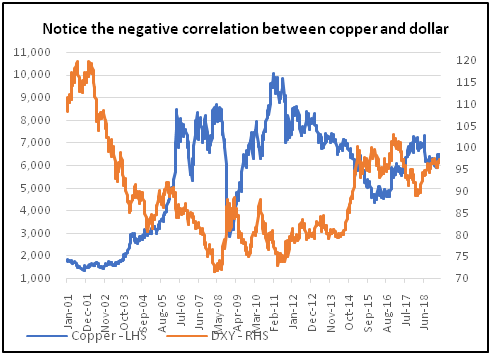 Another factor that has a strong bearing on copper price is US monetary policy and the dollar. The reason for this is that global benchmark copper prices are expressed in terms of dollar, both on the LME and on the COMEX. A strengthening dollar makes it more expensive for holders of foreign currency to buy copper, thereby lowering its demand and subsequently prices. Conversely, a weakening dollar makes it less expensive for holders of foreign currency to buy copper, thereby increasing its demand and prices. As such, there is a tendency for copper to underperform when the dollar is strengthening, and vice versa. Hence, one must know what the prevailing trend of the dollar is, to understand its potential impact on copper prices. As already stated in the previous chapter, one of the key factors that determine the trajectory of the dollar is the US monetary policy. A hawkish policy (or one where interest rates are trending higher) is positive for dollar and hence negative for copper, while a dovish policy (or one where interest rates are trending lower) is negative for dollar and hence positive for copper. Notice in the chart that when dollar was in a major downtrend till 2007, copper was in a very powerful uptrend. Post 2008, the dollar made a major bottom and has been heading higher since then. This in turn marked a major top in copper prices, which have been heading lower ever since.
Another factor that has a strong bearing on copper price is US monetary policy and the dollar. The reason for this is that global benchmark copper prices are expressed in terms of dollar, both on the LME and on the COMEX. A strengthening dollar makes it more expensive for holders of foreign currency to buy copper, thereby lowering its demand and subsequently prices. Conversely, a weakening dollar makes it less expensive for holders of foreign currency to buy copper, thereby increasing its demand and prices. As such, there is a tendency for copper to underperform when the dollar is strengthening, and vice versa. Hence, one must know what the prevailing trend of the dollar is, to understand its potential impact on copper prices. As already stated in the previous chapter, one of the key factors that determine the trajectory of the dollar is the US monetary policy. A hawkish policy (or one where interest rates are trending higher) is positive for dollar and hence negative for copper, while a dovish policy (or one where interest rates are trending lower) is negative for dollar and hence positive for copper. Notice in the chart that when dollar was in a major downtrend till 2007, copper was in a very powerful uptrend. Post 2008, the dollar made a major bottom and has been heading higher since then. This in turn marked a major top in copper prices, which have been heading lower ever since.
Supply-side factors
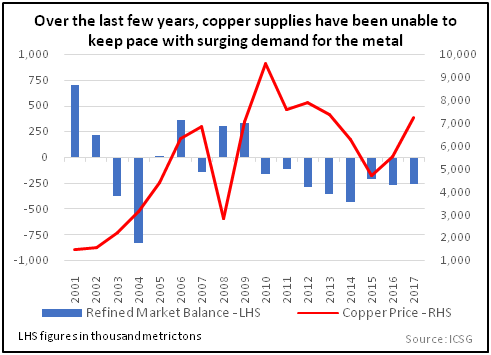 Supply-side factors have a strong bearing on copper price. There are two ways through which copper can be derived. The most dominant way is called primary copper production, wherein copper is derived from mine output. In 2017, primary copper production accounted for around 83% of total output. The other way is called secondary copper production, wherein copper is derived from secondary scrap. This accounted for the remainder, or 17%, of total output in 2017.
Supply-side factors have a strong bearing on copper price. There are two ways through which copper can be derived. The most dominant way is called primary copper production, wherein copper is derived from mine output. In 2017, primary copper production accounted for around 83% of total output. The other way is called secondary copper production, wherein copper is derived from secondary scrap. This accounted for the remainder, or 17%, of total output in 2017.
Given that mine output occupies a bulk of the share, one must keep a close eye on this side of copper supply. Any unexpected events such as labour strikes, natural disasters, geopolitical issues etc. in key mine producing regions can significantly reduce supplies, and thereby underpin copper prices. Chile and Peru are two of the largest copper producing nations in the world, who in 2017 accounted for around 27% and 12% of global mine output, respectively. Combined, they contribute almost two-fifths of world mine production. Hence, it is necessary to monitor supply situation in these two regions.
While secondary production occupies only a small share in total production, it must not be overlooked. Given that demand for copper steadily increases over time as economies develop and need for the metal shoots up, it is necessary for supplies to keep pace with rising demand. As such, any unexpected shortage from secondary production can tighten the demand-supply situation and thereby increase volatility in copper prices. This side of copper supply is more sensitive to short-term fluctuations in copper price. A sustained decline in copper price tends to reduce scrap supplies, and vice versa.
Copper inventories
Copper inventories play a very important role in determining the price trajectory of copper. The three major exchanges that release the inventory data are LME, COMEX, and SHFE. Of these, LME inventory data is arguably the most watched out for data as far as copper inventories are concerned. It is released every working session during the early European hours.
Put it in simple words, the data reveals the quantity of copper that is stored at LME-designated warehouses in the form of inventories. During periods of economic strength, there is a tendency for inventories to reduce, as demand for copper goes up, and vice versa. As such, falling inventory levels usually coincide with rising copper prices, while rising inventory levels often coincide with falling copper prices.
Traders often compare inventories with price spreads (difference between spot and futures copper price) to understand how tight the physical markets are. Falling inventories, if accompanied with backwardation (spot price trading above futures price), signal shortage of copper in the market and usually indicate that prices could strengthen until such a scenario exists. Similarly, rising inventories, if accompanied with contango (spot price trading below futures price), signal ample supply of copper in the market and typically indicate that prices could weaken until such a scenario prevails.
Market risk appetite
Short-term movement in copper price is also driven by risk appetite prevailing in the markets. Given that copper is an industrial commodity, its price tends to move in sync with riskier assets such as equities and other industrial commodities. Generally, copper benefits when risk appetite is strong, and it comes under pressure when risk aversion is strong.
How to trade copper
Copper prices are as much impacted by demand-side factors as they are by supply-side factors. When trading the red metal, some of the key things to keep a track of are as mentioned below:
-
Monitor LME data regularly in order to identify trends in inventories and to know if they are at an extreme or are reversing.
-
Monitor economic data from key copper consuming nations, most importantly from China. Also keep a track of data releases from the US, EU, and India.
-
Some of the key data to keep a track of are housing, GDP, infrastructure, manufacturing, and inflation. Also monitor the central bank and government policies, particularly that of China and the US, to understand whether they are accommodative or tight.
-
Keep a track on movements in global equities and other commodities to understand the prevailing sentiment in the market.
-
Keep a watch on the medium-term and long-term trend of the dollar, given the strong negative correlation between the two especially at major turning points.
-
Keep a periodic watch on supply-side developments, especially in Chile and Peru, given that these two nations account for almost two-fifths of world mine supply.
-
Keep a watch on the refined market balance (refined production less refined consumption) and periodic reports released by agencies such as the International Copper Study Group (ICSG).
-
Compare LME inventories with LME spreads, as this gives clues as to the prevailing tightness of copper in the physical markets.
Next Chapter
Comments & Discussions in
FYERS Community
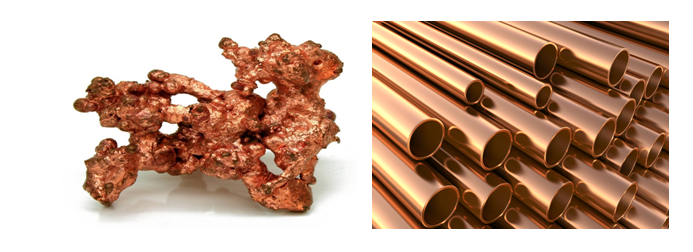
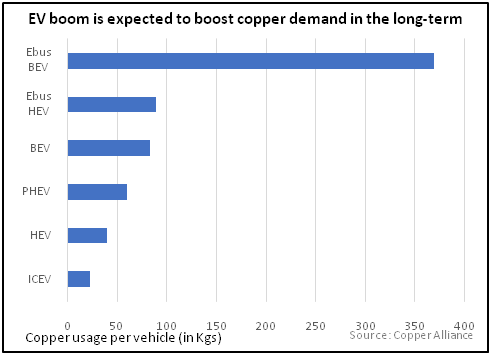
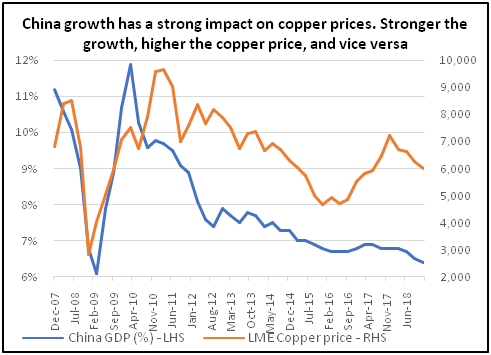
Shridhar commented on June 26th, 2019 at 11:27 PM
why do commodities have different expiry dates?
tejas commented on July 2nd, 2019 at 10:43 AM
Hi Shridhar, it has to do with the fact that a lot of commodities have physical settlements, which consumes a lot of time due to the various steps involved. Also, the time-wise demand-supply is different especially for agricultural commodities.